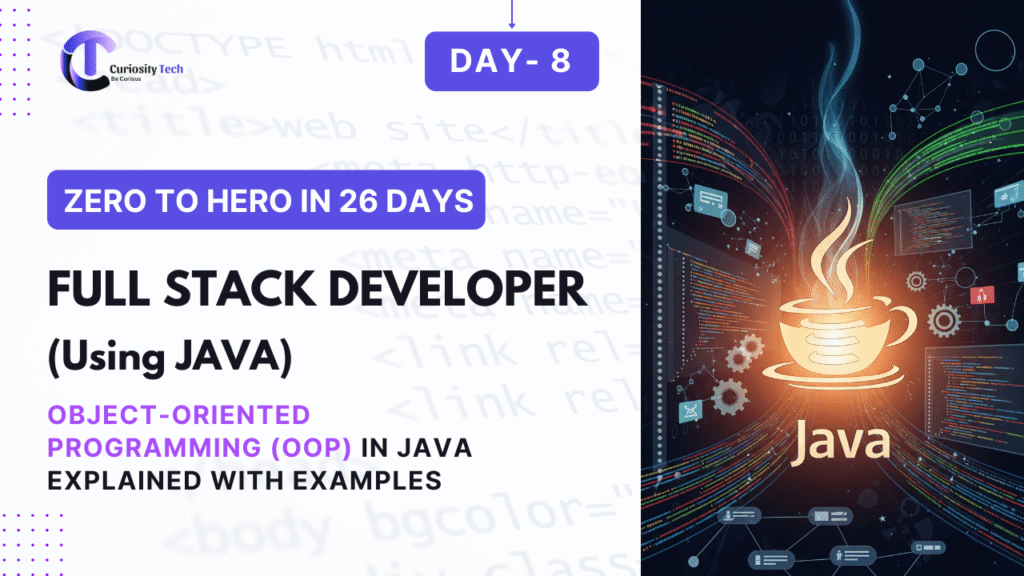Introduction
Imagine building a city in code. Each building, road, and vehicle has a purpose and interacts seamlessly with others. In Java, Object-Oriented Programming (OOP) is the blueprint for this city. It allows developers to structure applications like a living ecosystem, where every object has properties, behaviors, and relationships.
At CuriosityTech.in, we guide aspiring Java full stack developers to master OOP concepts not just theoretically, but through real-world examples.
Understanding Objects and Classes through a Real-Life Analogy
Think of a Car:
- Class (Blueprint): A Car defines what properties (color, model, speed) and behaviors (start, stop, accelerate) it can have.
- Object (Instance): Your Honda Civic or Toyota Corolla is a specific car object created from the Car class.
class Car {
String model;
int speed;
void start() {
System.out.println(model + ” is starting.”);
}
void accelerate(int increment) {
speed += increment;
System.out.println(model + ” accelerated to ” + speed + ” km/h.”);
}
}
public class Main {
public static void main(String[] args) {
Car myCar = new Car();
myCar.model = “Honda Civic”;
myCar.speed = 0;
myCar.start();
myCar.accelerate(50);
}
}
Outcome: The program prints actions of your car object interacting with its environment—just like real life.
The Four Pillars of OOP in Java
Instead of a dry list, let’s visualize OOP as a team of superheroes, each with a role:
- Encapsulation – The Shield:
Protects your data. Only allows safe access through methods (getters/setters).
Example: private int health; public int getHealth() { return health; } - Inheritance – The Legacy:
Heroes can pass abilities to sidekicks. A class inherits methods and properties from a parent class.
Example: class ElectricCar extends Car { void charge() {} } - Polymorphism – The Shape-Shifter:
Same action, multiple forms. Methods behave differently based on parameters or object type.
Example: Overloaded accelerate(int speed) and accelerate(int speed, int boost) - Abstraction – The Secret Identity:
Hide unnecessary details. Expose only what matters via abstract classes or interfaces.
Example: abstract class Vehicle { abstract void move(); }

OOP in Java: Superheroes of Full Stack Development
- Sections: Class & Object → Encapsulation → Inheritance → Polymorphism → Abstraction
- Visual: Comic-style superheroes representing each pillar
- Use: Blog illustration and social media promotion

Practical Scenario: Online Shopping Application
Imagine you’re building a Java full stack e-commerce app:
- Product class with properties like name, price, stock.
- User class with methods for login, addToCart, checkout.
- Order class encapsulates purchase details.
OOP allows each class to interact safely and predictably, making your code modular, maintainable, and scalable.
class Product {
String name;
double price;
void display() {
System.out.println(name + “: $” + price);
}
}
Humanized Advice
When learning OOP:
- Think in real-world terms. Every entity in your application is an object.
- Don’t just memorize concepts; apply them in mini-projects.
- Experiment with extending classes and overriding methods—it’s the best way to understand inheritance and polymorphism.
At CuriosityTech.in, we provide projects and exercises that simulate real-world apps, ensuring concepts stick beyond theory.
Conclusion
OOP is not just a programming style—it’s a mindset. By mastering OOP in Java, you can design complex systems with clarity, maintainability, and efficiency. Your journey from Java syntax to full stack mastery hinges on understanding how objects interact and inherit behavior.
CuriosityTech.in bridges this gap, providing guidance, exercises, and projects that make OOP intuitive and applicable to real-world development.



